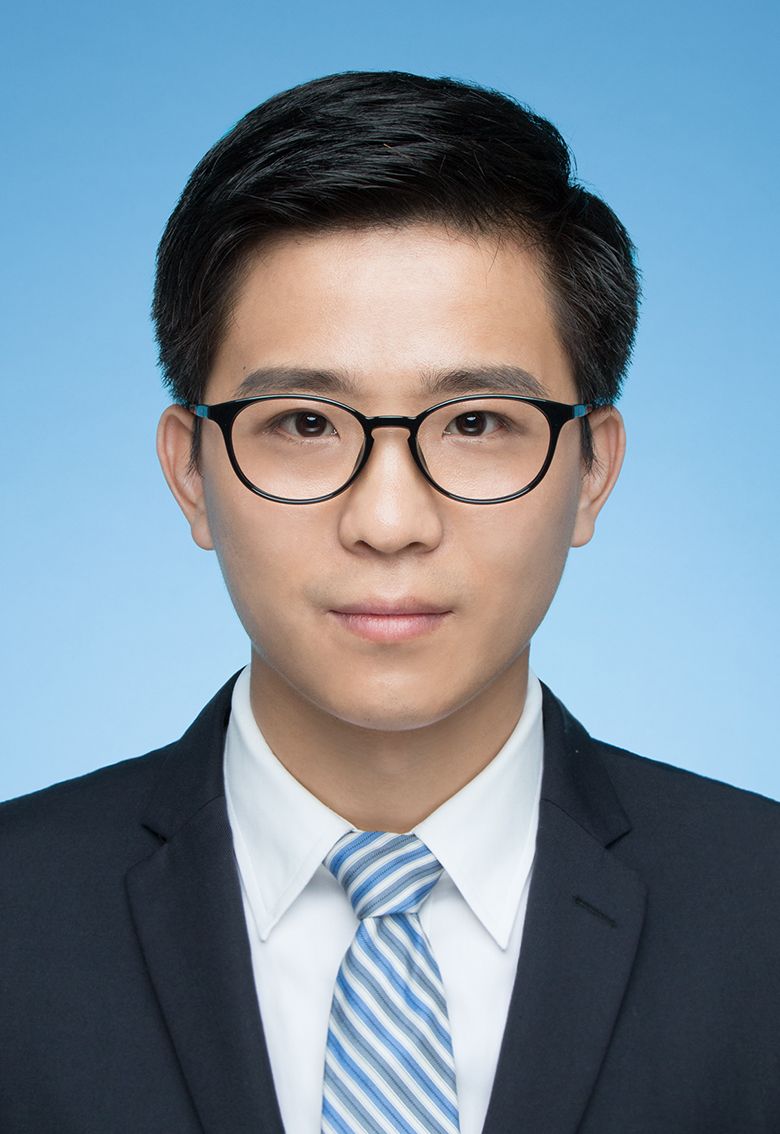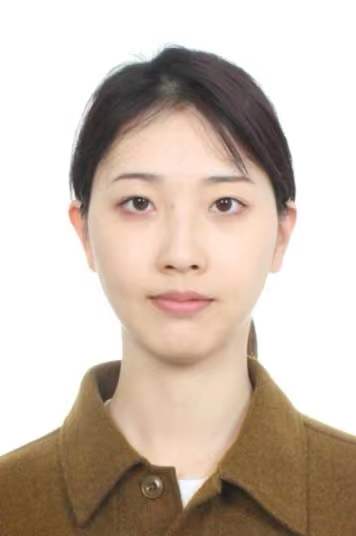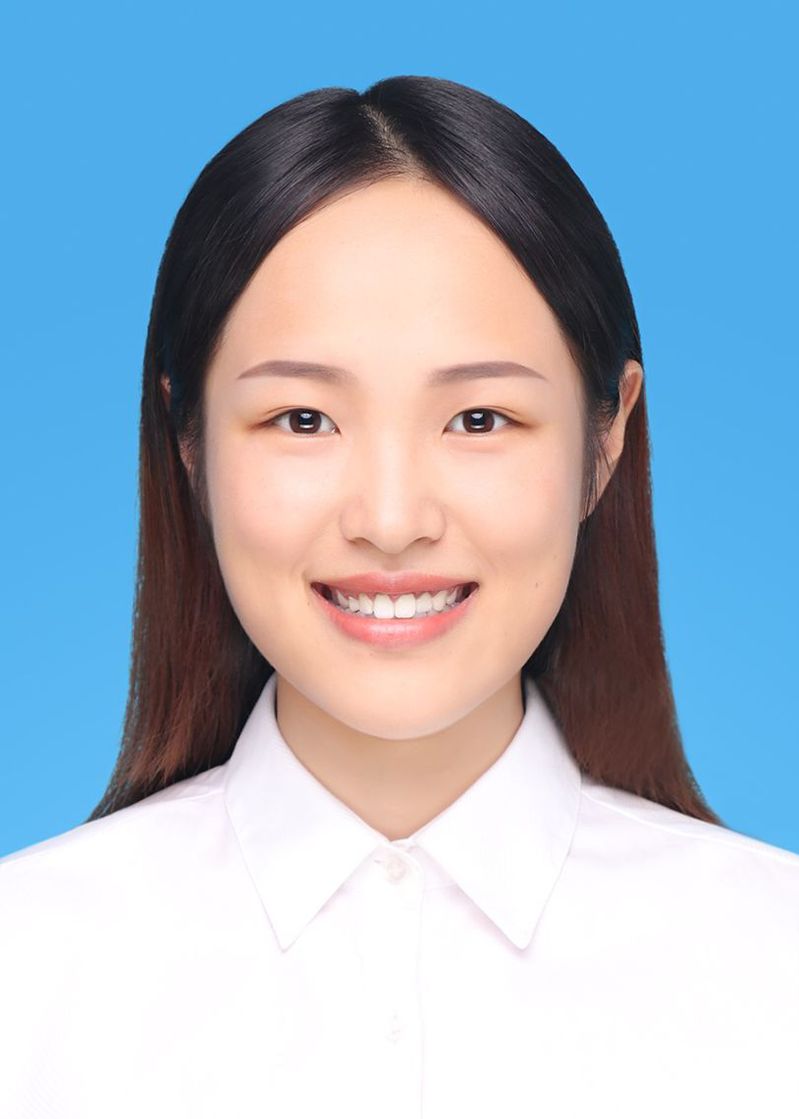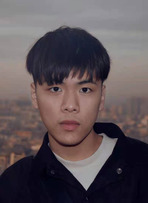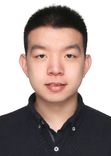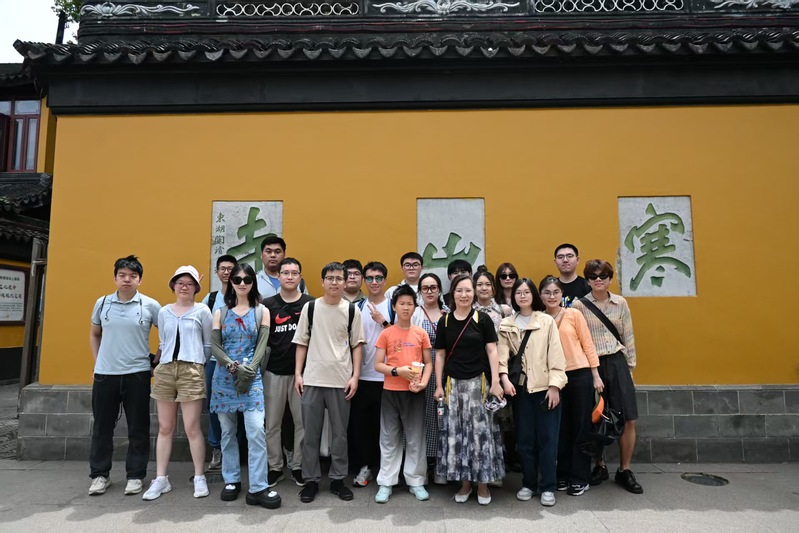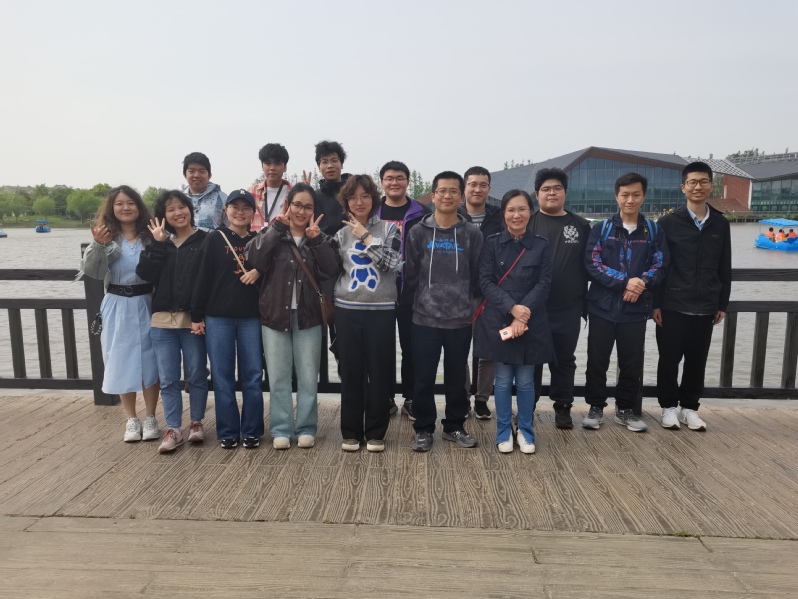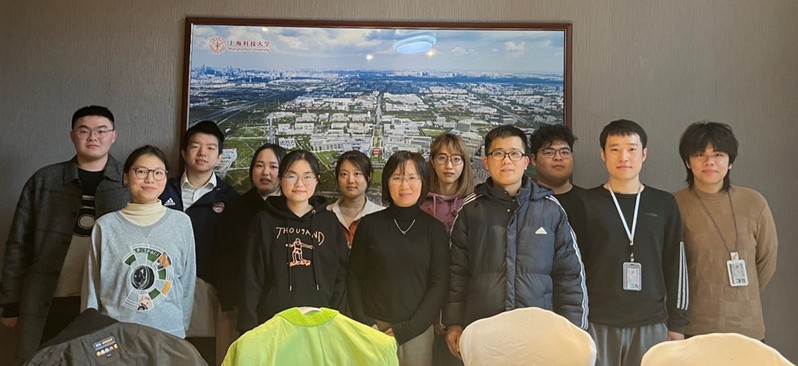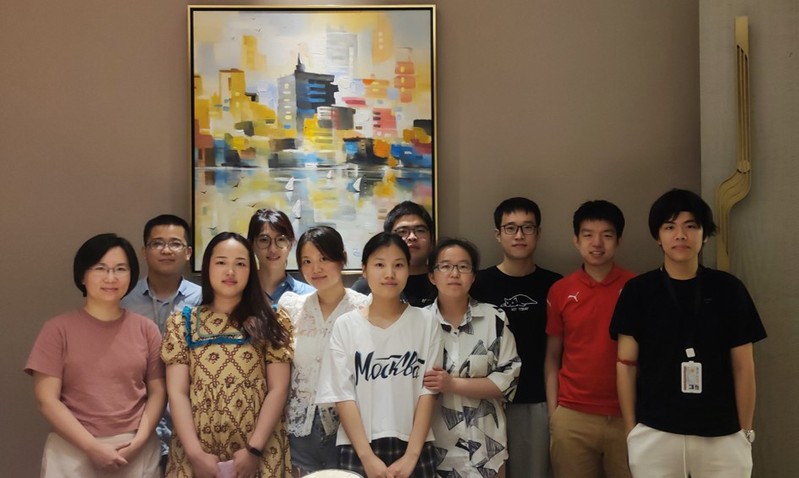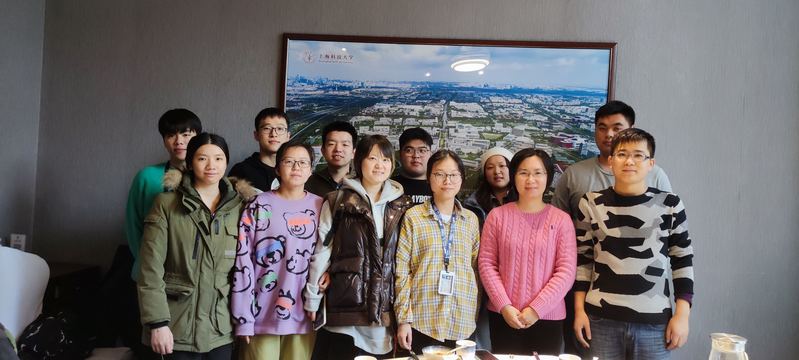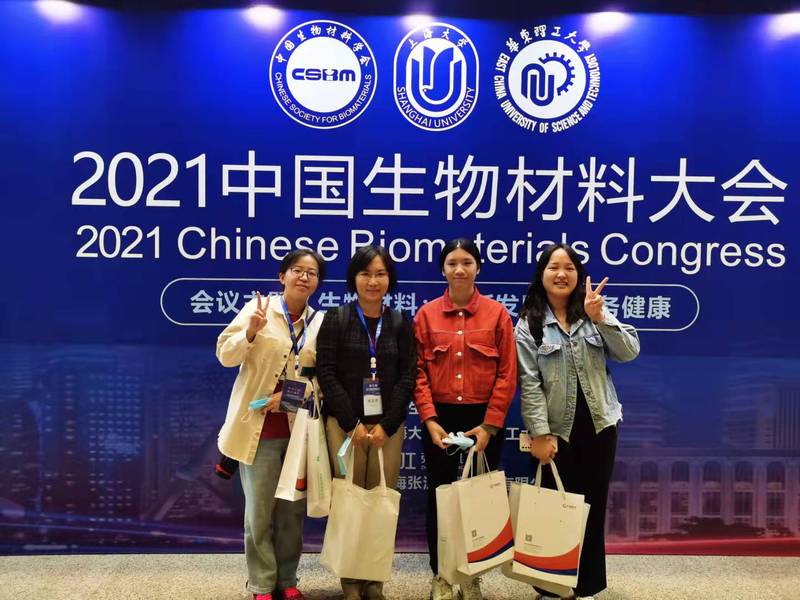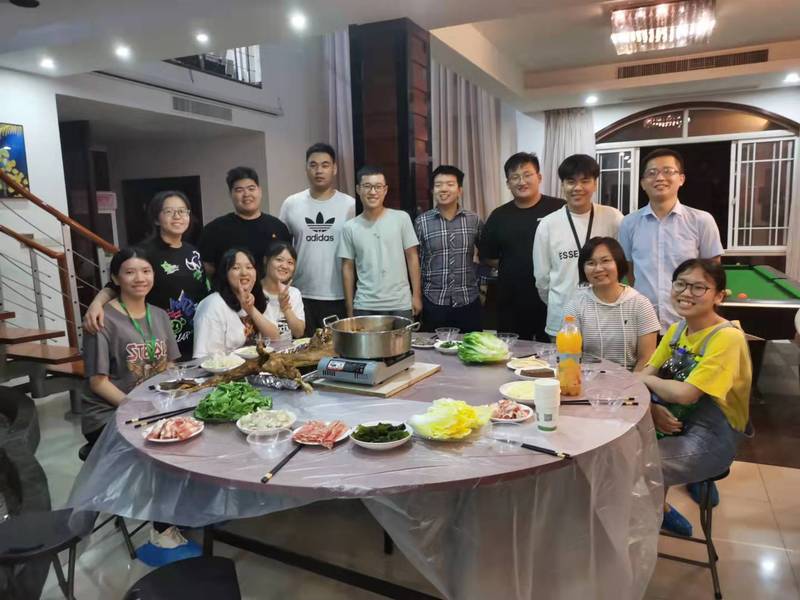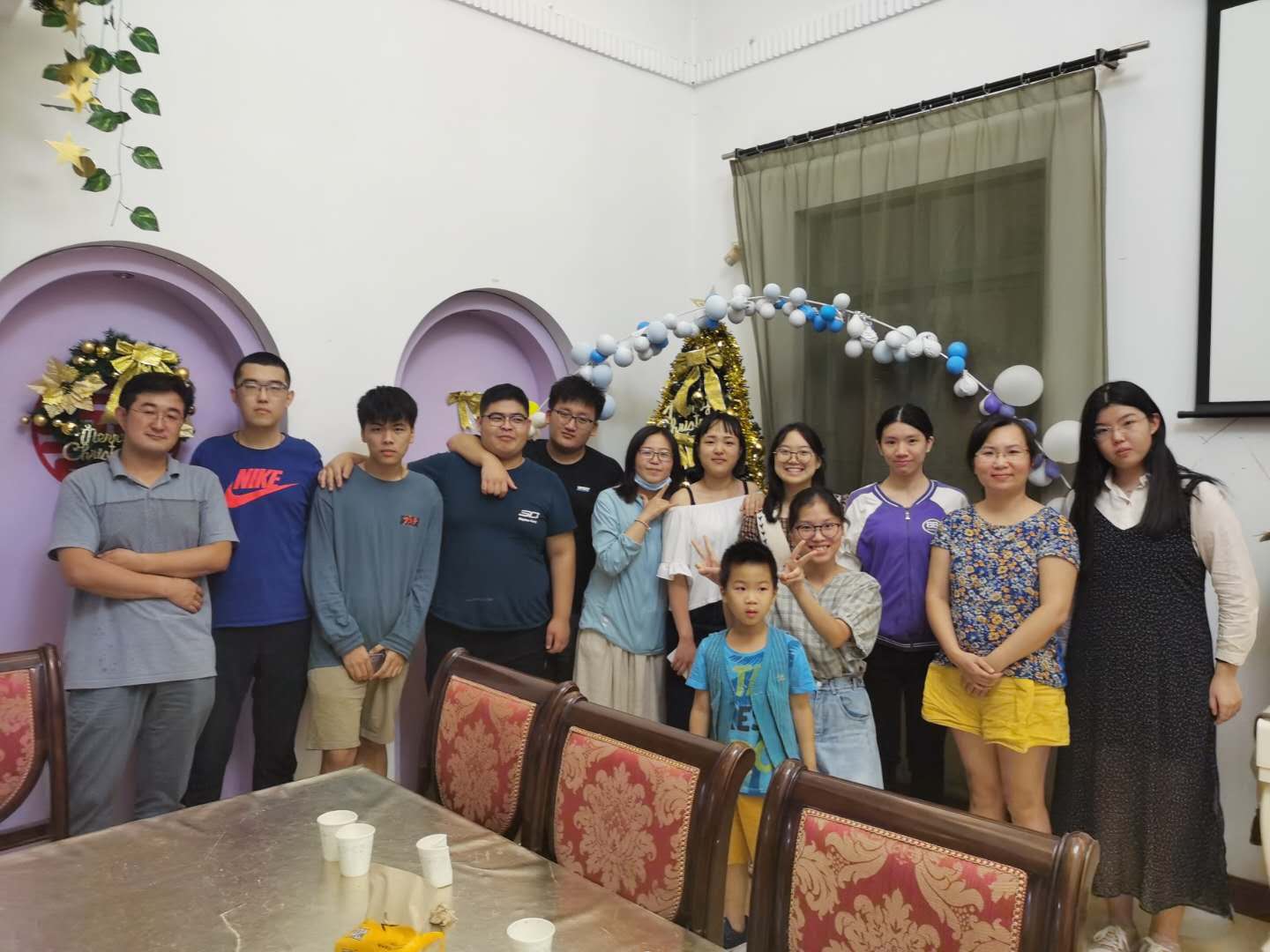Our research focus on developing advanced dynamic biomaterials mimicking extracellular matrix to understand how cells interact with their environment and to gain insight into the design of next-generation,living biomaterials that integrate, cooperate, and communicate with biological systems.
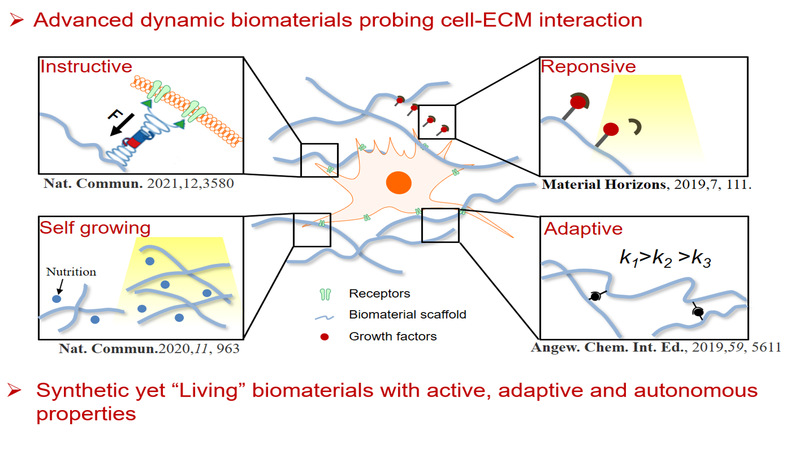
In the current stage, we are particularly interested on two topics:
(1) Advanced dynamic biomaterial probing cell-ECM interaction
We develop new classes of user-programmable hydrogels with special emphasis on the use of multiple photochemical reactions that govern 4D material responsiveness, physicochemical tunability, and biophysical alterations, in an orthogonal manner. For example, one of the central challenges in cellular mechanotransduction is the understanding of the molecular mechanisms that enable cells to modulate their mechanical responses and to sense and actively direct the biophysical properties of the ECM. To elucidate these fundamental mechanisms, cellular mechanotransduction should be studied at molecular levels. We develop molecular tools that can apply or detect forces at individual receptors within readily formed cell-ECM or cell-cell contacts.
2) Synthetic yet ”living” biomaterials with active, adaptive and autonoumous properties
We develop new generations of molecular materials and systems with unprecedented levels of functionalities – adaptive and interactive properties. We aim to emulate the functional behavior observed in living systems within synthetic chemical framework through non-equilibrium chemical reaction network with constant energy dissipation, kinetic control and feedback loops.
Welcome undergrads and graduate students with different backgrounds to join the group. We are recruiting one RESEARCH SCIENTIST and one POSTDOC (with organic chemistry, polymer chemistry or biomaterials background). Feel free to contact the PI.
# Equal contribution,* Corresponding author
1. B. Li, Q. Fu, Y. Lu, C. Chen, Y. Zhao, Y. Zhao, M. Cao, W. Zhou, X. Fan, X. Jiang, P. Zhao, Y. Zheng*, 3D hydrogel platform with macromolecular actuators for precisely controlled mechanical forces on cancer cell migration, Nat. Commun., 2025,16, 4831.
2. Y. Lu, C.Chen, H. Li, P. Zhao, Y. Zhao, B. Li, W. Zhou, G. Fan,D. Guan*,Y. Zheng*, Visible Light-Responsive Hydrogels for Cellular Dynamics and Spatiotemporal Viscoelastic Regulation,Nat. Commun., 2025,16, 1365
3. Y. Zhao# , B. Li,# , X. Fu# , P. Zhao , Y. Zhao , W. Zhou , Y. Lu , Y. Zheng*, Autocatalytic Reactions Networks: A Pathway to Spatial Temporal Mastery in Dynamic Materials, Angew. Chem. Int. Ed. 2024, e202415582.
4. P. Zhao#, Y. Zhao# , Y. Lu, L. Xu, B. Li, Y. Zhao, W. Zhou, P. Yan, Y. Wang, K. Cao, Y. Zheng*, Non-Equilibrium Dissipative Assembly with Switchable Biological Functions, Angew. Chem. Int. Ed. 2024, e202409169.
5. P. Zhao#, L. Xu#, B. Li, Y. Zhao, Y. Zhao, Y. Lu, M. Cao, G. Li, T. Weng, H. Wang, Y. Zheng*, Non-Equilibrium Assembly of Atomically-Precise Copper Nanoclusters, Adv. Mater. 2024, 2311818.
6. Y. Zhao#, P. Zhao#, J. Zhang#, Y. Zhao, B. Li, G. Hao, Y. An, W. Zhou, Y. Lu, L. Chou, Y. Zheng*, CCS Chem.2023, 5, 1-11.
7. W. Zhou#, G. Shi#, P. Zhao, G. Zhang, P. Yang, B. Li, B. Li, X. Wan*, Y. Zheng*, Dynamic helical cationic polyacetylenes for fast and highly efficient killing of bacteria, Acta. Biomater., 2023,161, 134-143.
8. N. Cheng, Y. Zhang, Y. Wu, B. Li, H. Wang, S. Chen, P. Zhao, J. Cui, X. Shen, X. Zhu, Y. Zheng*, Hydrogel platform capable of molecularly resolved pulling on cells for mechanotransduction, Material Today Bio, 2022,17,100476.
9. J. Zhang, J. Liu, H. Li, X. Li, Y. Zhao, P. Zhao, J. Cui, B. Yang, Y. Song, Y. Zheng*, Programming hydrogels with complex transient behaviors via autocatalytic cascade reactions, ACS Appl. Mater. Interfaces 2022, 14, 17, 20073–20082.
10. L. Yang, S. Dong, W. Zhou, Q. Wu, Y. Zheng, J.Cui*, Calenderable supramolecular perfluorogels for facile fabrication of slippery coatings, Chem. Eng. J. 2021, 127901.
11. L. Xue, X. Xiong, B. P. Krishnan, F. Puza, S. Wang, Y. Zheng*, J. Cui*, Light-regulated growth from dynamic swollen substrates for making rough surfaces, Nat. Commun. 2020, 11, 963.
12. X. Zhou#, Y. Zheng#, H. Zhang, L. Yang, Y. Cui, B. P. Krishnan, S. Dong, M. Aizenberg, X. Xiong, Y. Hu, J. Aizenberg, J. Cui*, Reversibly growing crosslinked polymers with programmable sizes and properties, Nat. Commun. 2023, 14, 3302.
13. Y. Chen, Y. Liu, R. Yu, Y. Zhao, J. Lu, G. Chen, Y. Zheng, C. Ye*, Dynamically switchable 3D shape-morphing and rotation from liquid crystal elastomer actuators, ACS Appl. Mater. Interfaces, 2025, 17, 33244.
14. Y. Dong, S. Qian, X. Wang, W. Zhang, W. Lu, J. Qu, M. Cui, L. Chen, Y. Zhao, Y. Gao, M. Giomo, A. Urciuolo, J. Feng, Y. Zheng, B. Jiang, R. Shen, X. Zhu, N. Elvassore, In situ tailored confining microenvironment for lung cancer spheroids, Materials Today Bio, 2025, 31, 101602.
15. N. Sun, S. Mo, Y. Cai, Y. Zhao, Y. Han, Y. Zheng, T. He, Bicontinuous porous substrates by polysulfone/2-pyrrolidone binary system for high-performance forward osmosis membranes, J. Membr. Sci, 2025, 717, 123614.
16. Y. Lv, Y. Zhang, F. Cui, Y. Zhang, Z. Wang, J. Yang, Q. Liu, Y. Zhao, Y. Zheng, C. Xu, J. Yan, Harnessing Self-Condensing Vinyl Copolymerization for Well-Defined Redox-Active Hyperbranched Polymers Enabled by Flow Chemistry, 2025.
Before joining ShanghaiTech:
1.
Y. Zheng# , M. K.L. Han# , R.g Zhao# , J. Blass# , J. Zhang, D.W. Zhou, J. Colard-Itté, D. Dattler, A. Çolak, M. Hoth, A. J. García, B. Qu, R. Bennewitz, N. Giuseppone, A. del Campo*, Optoregulated force application to cellular receptors using molecular motors, Nat. Commun. 2021, 12, 3580.
J. Feng, Y. Zheng, S. Bhusari, M. Villiou, S. Pearson, A. del Campo*, Printed degradable optical waveguides for guiding light into tissue, Adv. Funct. Mater. 2020, 2004327.
F. Puza, Y. Zheng*, L. Han, L. Xue and J.Cui*, Physical entanglement hydrogels: ultrahigh water content but good toughness and stretchability, Polym. Chem., 2020, 11, 2339.
L. Han#,Y. Zheng#, H. Luo#, J. Feng, R. Engstler, L. Xue, G. Jing*, X. Deng*, A. del Campo, J. Cui*, Macroscopic self-evolution of dynamic hydrogels to create hollow interiors, Angew. Chem. Int. Ed., 2019, 59, 5611.
Y. Zheng*, M. Han, Q. Jiang, J. Feng, Bin. Li, A. del Campo, “4D hydrogels for dynamic cell culture with orthogonal, wavelength-regulated stiffening and cell adhesiveness”, Mater. Horiz. 2019, 20, 111-116.
Y. Zheng, A. Farrukh, A. del Campo “Optoregulated Biointerfaces to Trigger Cellular Responses”, Langmuir, 2018, 34, 48,14459.
Y. Zheng*, D. Wang, J. Cui, M. Mezger, G. K. Auernhammer, K. Koynov, H.-J. Butt, T. Ikeda, “Redox-Responsive and Thermoresponsive Supramolecular Nanosheet Gels with High Young's Moduli”, Macromol. Rapid Commun. 2018, 39, 1800282.
Y. Zheng, X. Liu, J. Xu, H. Zhao, X. Hou, J. Cui “Thermo-responsive mobile interfaces with switchable wettability, optical properties, and penetrability”, ACS Appl. Mat. Interfaces, 2017, 9, 35483-35491.
Z.-S. Wu, Y. Zheng, S. Zheng, S. Wang, C. Sun, K. Parvez, T. Ikeda, X. Bao, K. Muellen, X. Feng, “Stacked-Layer Heterostructure Films of 2D Thiophene Nanosheets and Graphene for High-Rate All-Solid-State Pseudocapacitors with Enhanced Volumetric Capacitance.” Adv. Mater., 2017, 29, 1602960.
Y. Zheng, J. Cui, T. Ikeda “Click functionalization of phenyl-capped bithiophene on azide-terminated self-assembled monolayers”, Applied Surface Science, 2015, 355, 213-217.
Y. Zheng, H. Zhou, D. Liu, F. George, W. Manfred; K. Kaloian, M. Mezger, H.-J. Butt, T. Ikeda, “Thiophene Supramolecular Nanosheet”, Angew. Chem. Int. Ed., 2013, 52, 4845-4848.
Y. Zheng, D. Liu, H.-J. Butt, T. Ikeda, “Synthesis and Properties of Phenyl-capped Cyclohexyl[c]-oligothiophenes”, Synth. Met., 2013, 181, 1-9.
Y. Zheng, J. Cui, J. Zheng, X. Wan, “Near-infrared Electrochromic and Chiroptical Switching Polymers: Synthesis and Characterization of Helical Poly(N-propargylamides) Carrying Anthraquinone Imide Moieties in Side Chains”, J. Mater. Chem., 2010, 20, 5915-5922.
Y. Zheng, K. Yao, J. Lee, D. Chandler, J. Wang, C. Wang, F. Chu, C. Tang, “Well-Defined Renewable Polymers Derived from Gum Rosin”, Macromolecules, 2010, 43, 5922-5924.
Y. Zheng, J. Zheng, L. Dou, W. Qiao, X. Wan, “Synthesis and Characterization of a Novel kind of Near-infrared Electrochromic Polymers Containing an Anthraquinone Imide Group and Ionic Moieties”, J. Mater. Chem., 2009, 19, 8470-8477.
赵鹏 助理研究员 2019年6月-2021年7月 上海交通大学 博士后 2014年9月-2021年6月 华东理工大学 博士 2010年9月-2014年6月 山东科技大学 学士 邮箱:zhaopeng2@shanghaitech.edu.cn | |
蒋晓宇 博士后,上海科技大学 博士 |
周维 19级研究生,青岛科技大学 学士 |
赵远峰 20级研究生,北京化工大学 学士 | |
樊晓良 22级研究生, 南京工业大学 学士 邮箱:fanxl2022@shanghaitech.edu.cn | |
卢彦 20级研究生,沈阳药科大学 学士 |
徐锡文 23级研究生, 山东师范大学 学士 |
赵英帅 21级研究生,青岛科技大学 学士 邮箱: zhaoysh@shanghaitech.edu.cn |
刘艺程 23级研究生,山东大学 学士 邮箱:liuych2023@shanghaitech.edu.cn |
李博涵 21级研究生,上海科技大学 学士 |
王耀文 24级研究生,华东理工大学 学士 邮箱:wangyw2024@shanghaitech.edu.cn |
张敏玥 24级研究生,南京信息工程大学 学士 邮箱:zhangmy22024@shanghaitech.edu.cn |
赵润萌 24级研究生,吉林大学 学士 邮箱:zhaorm2024@shanghaitech.edu.cn |
2025年6月,恭喜曹明慧和陈劭杰同学顺利通过毕业答辩 2025年4月,恭喜李博涵和付晴雨同学在Nature Communications上发表高质量论文 2024年11月,恭喜卢彦同学喜提Nature Communications一篇 2024年11月,恭喜赵英帅和李博涵的工作成功发表在Angew. Chem.期刊上 2024年9月,欢迎王耀文、张敏玥、赵润萌和陈骋同学加入课题组 2023年9月,欢迎刘艺程、徐锡文和韩盛同学加入课题组 2023年3月,郑宜君获得上海市自然科学基金面上项目的资助 2022年12月,祝贺蒋晓宇博士获得上海市超级博士后计划和博士后面上基金的资助 2022年7月,欢迎蒋晓宇博士加入课题组开展博士后研究工作 2021年9月,欢迎赵英帅,李博涵,曹明慧和陈邵杰等加入课题组 2021年7月,欢迎赵鹏助理研究员加入课题组开展研究工作 2020年9月,郑宜君获得国家自然科学基金面上项目的资助 2020年9月,欢迎研究生卢彦,徐林洁同学加入课题组 2020年8月,欢迎本科生郑江楠同学加入课题组开展科研实践 2020年7月,欢迎电子科技大学博士生王宏同学进组交流 2020年7月,欢迎本科生苏睿,李小禾,曹宗宇同学进组开展科研实践 2019年12月,欢迎准研究生赵远峰同学加入课题组
曹明慧,2021级物质学院研究生 陈劭杰,2021级物质学院研究生 徐林洁, 2020级物质学院研究生 张静宜, 2019级物质学院研究生
|




